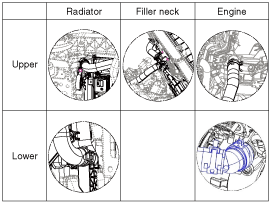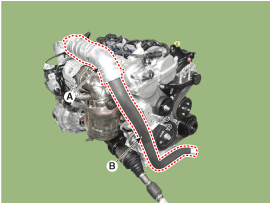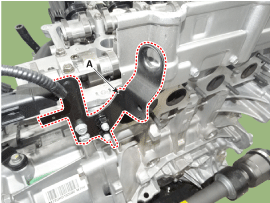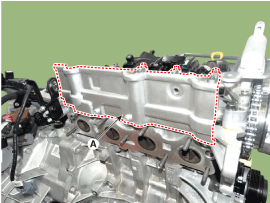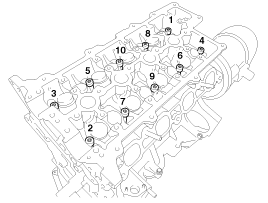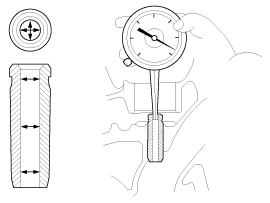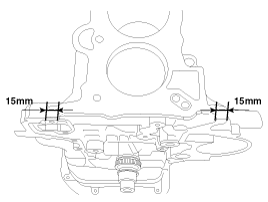Hyundai Kona: Cylinder Head Assembly / Cylinder Head Repair procedures
| Removal |
|
|
| 1. |
Disconnect the battery negative terminal.
|
| 2. |
Remove the engine cover.
(Refer to Engine and Transaxle Assembly - "Engine Cover")
|
| 3. |
Remove the air duct and air cleaner assembly.
(Refer to Intake and Exhaust System - "Air Cleaner")
|
| 4. |
Remove the battery.
(Refer to Engine Electrical System - "Battery")
|
| 5. |
Disconnect the ECM connector and then remove the battery tray.
(Refer to Engine Electrical System - "Battery")
|
| 6. |
Remove the battery tray.
(Refer to Engine Electrical System - "Battery")
|
| 7. |
Remove the engineroom under cover.
|
| 8. |
Loosen the drain plug and drain the coolant. Open the radiator cap to
make rapid draining.
(Refer to Cooling System - "Coolant")
|
| 9. |
Remove the radiator upper hose (A).
|
| 10. |
Remove the radiator lower hose (A).
|
| 11. |
Disconnect the intercooler inlet hose and pipe.
|
| 12. |
Remove the intercooler outlet hose and pipe.
|
| 13. |
Disconnect the engine wiring connector and haness clamp and then remove
the cylinder head protector and wiring from engine.
|
| 14. |
Disconnect the brake booster vacuum hose (A).
|
| 15. |
Remove the heater hoses (A).
|
| 16. |
Remove the vacuum pipe assembly (A).
|
| 17. |
Remove the cylinder head cover.
(Refer to Cylinder Head Assembly - "Cylinder Head Cover")
|
| 18. |
Remove the timing chain cover.
(Refet to Timing System - "Timing chain cover & Oil Pump Assembly")
|
| 19. |
Remove the timing chain.
(Refer to Timing System - "Timing Chain")
|
| 20. |
Remove the camshaft.
(Refer to Cylinder Head Assembly - "CVVT & Camshaft")
|
| 21. |
Remove the intake manifold.
(Refer to Intake and Exhaust System - "Intake Manifold")
|
| 22. |
Remove the turbo manifold.
(Refer to Intake and Exhaust System - "Exhaust Manifold")
|
| 23. |
Remove the delivery pipe assembly.
(Refer to Fuel System - "Delivery Pipe")
|
| 24. |
Disconnect the bypass hose, and then remove the water temperature control
assembly.
(Refer to Cooling System - "Water Temperature Control Assembly")
|
| 25. |
Remove the heater pipe.
(Refet to Cooling System - "Water Temperature Control Assembly")
|
| 26. |
Remove the intake OCV(Oil Control Valve).
(Refer to Fuel System - "CVVT Oil Control Valve")
|
| 27. |
Remove the rear hanger (A).
|
| 28. |
Remove the cylinder head cover heat protector (A).
|
| 29. |
Remove the cylinder head bolts, then remove the cylinder head.
|
| Disassembly |
|
| 1. |
Remove the MLAs (A).
|
| 2. |
Remove the valves.
|
| Inspection |
| Cylinder Head |
| 1. |
Inspect for flatness.
Using a precision straight edge and feeler gauge, measure the surface
the contacting the cylinder block and the manifolds for warpage.
|
| 2. |
Inspect for cracks.
Check the combustion chamber, intake ports, exhaust ports and cylinder
block surface for cracks. If cracked, replace the cylinder head.
|
| 1. |
Inspect the valve stems and valve guides.
|
| 2. |
Inspect the valves.
|
| 3. |
Inspect the valve seats.
|
| 4. |
Inspect the valve springs.
|
| Reassembly |
|
| 1. |
Install the valves.
|
| 2. |
Using the SST (09222-3K000, 09222-3K100), compress the spring and install
the retainer locks.
After installing the valves, ensure that the retainer locks are correctly
in place before releasing the valve spring compressor.
|
| 3. |
Lightly tap the end of each valve stem two or three times with the wooden
handle of a hammer to ensure proper seating of the valve and retainer
lock.
|
| 4. |
Install the MLA (Mechanical lash adjuster)s.
Check that the MLA (A) rotates smoothly by hand.
|
| Installation |
|
| 1. |
Install the cylinder head assembly.
|
| 2. |
Place the cylinder head carefully not to damage the gasket.
|
| 3. |
Install the cylinder head bolts with washers.
|
| 4. |
Install the head cover heat protector (A).
|
| 5. |
Install the rear hanger (A).
|
| 6. |
Install the oil control valve(OCV).
(Refer to Fuel System - "CVVT Oil Control Valve (OCV)")
|
| 7. |
Install the heater pipe.
(Refer to Cooling System - "Water Temperature Control Assembly")
|
| 8. |
Install the weter control assembly, and bypass hose.
(Refer to Cooling System - "Water Control Assembly")
|
| 9. |
Install the delivery pipe assembly.
(Refer to Fuel System - "Delivery Pipe")
|
| 10. |
Install the turbo manifold.
(Refer to Intake and Exhaust System - "Exhaust Manifold")
|
| 11. |
Install the intake manifold.
(Refer to Intake and Exhaust System - "Intake Manifold")
|
| 12. |
Install the cam shaft.
(Refer to Cylinder Head Assembly - "CVVT & Camshaft")
|
| 13. |
Install the timing chain.
(Refer to Timing System - "Timing Chain")
|
| 14. |
Install the timing chain cover.
(Refer to Timing System - "Timing chain cover & Oil Pump Assembly")
|
| 15. |
Install the cylinder head cover.
(Refer to Cylinder Head Assembly - "Cylinder Head Cover")
|
| 16. |
Install the vacuum pipe assembly (A).
|
| 17. |
Connect the heater hose (A).
|
| 18. |
Connect the brake vacuum hose (A).
|
| 19. |
Install in the reverse order of removal.
|
 Cylinder Head Components and components location
Cylinder Head Components and components location
Components
1. Cylinder head assembly
2. MLA
3. Retainer lock
4. Retainer
5. Valve stem seal
6. Valve spring
7. Valve spring seat
8. OCV (Oil Cont ...
 Cylinder Block
Cylinder Block
...
Other information:
Hyundai Kona (OS) 2018-2025 Service Manual: Special service tools
Special Service Tools
Tool Name / Number
Illustration
Description
Alternator pulley remover wrenchh
09373-27000
Removal and installation of alternator pulley
...
Hyundai Kona (OS) 2018-2025 Service Manual: Oil Level Gauge & Pipe Repair procedures
Removal and Installation
1.
Remove the oil lever gauge and pipe (A).
Tightening torque :
9.8 - 11.8 N.m (1.0 - 1.2 kgf.m, 7.2 - 8.7 lb-ft)
2.
Install in the reverse order of re ...




